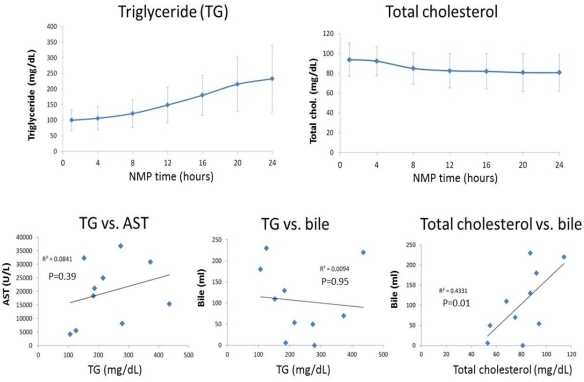Lipid Metabolism and Preservation of Discarded Steatotic Human Livers Using 24 Hours Ex-Vivo Normothermic Machine Perfusion.
Q. Liu, A. Nassar, G. Iuppa, B. Soliman, L. Buccini, M. Blum, T. Okamoto, T. Uso, A. Bennett, W. Baldwin, K. Abu-Elmagd, J. Fung, C. Miller, C. Quintini.
Cleveland Clinic, Cleveland, OH.
Meeting: 2016 American Transplant Congress
Abstract number: D123
Keywords: Liver metabolism, Liver preservation, Machine preservation, Triglycerides
Session Information
Session Name: Poster Session D: Ischemia Reperfusion Injury: Clinical Update
Session Type: Poster Session
Date: Tuesday, June 14, 2016
Session Time: 6:00pm-7:00pm
 Presentation Time: 6:00pm-7:00pm
Presentation Time: 6:00pm-7:00pm
Location: Halls C&D
One primary reason to discard donor livers after procurement is severe steatosis. The impact of normothermic machine perfusion (NMP) on lipid metabolism and preservation of steatotic human livers has not been studied. We perfused 10 discarded human livers with oxygenated NMP for 24 hours (after cold ischemia of 4-6 hours). The perfusate consisted of packed RBCs and fresh-frozen plasma (2.5L total volume and 20-25% hematocrit). All livers had several degrees of steatosis. Perfusate analysis showed an increase in triglyceride (TG) levels in all livers  starting from the 1st hour (median 127 mg/dL; interquartile range 95-149) to 24th hour (203;171-304)(p=0.004). Total cholesterol decreased from 101(83-109) to 85(72-94) mg/dL (p=0.11). 50% of the livers produced a significant amount of bile (≥5 ml/hr). Bile production and aspartate transaminase (AST) release in the perfusate did not correlate to TG in perfusate at 24th hour NMP, while the total cholesterol had a significant positive correlation to bile production (r=0.66; p=0.01) but a non-significant correlation to AST(r=0.54; p=0.13). The semi-quantitative scoring of steatosis did not show a significant difference from start to end of NMP. There was no significant intra-individual difference in the degree of steatosis based on quantitative image analysis. This is the first study to determine the lipid profile of the perfusate using ex-vivo human liver perfusion in 24 hours NMP preservation. The data show that active TG metabolism occurs ex-vivo regardless of bile production (one of the most reliable marker of ex-vivo function) and degree of AST release. Our results indicate that long perfusion duration (24hrs) is not sufficient to decrease the amount of steatosis as measured by histological analysis. Pharmacological intervention may be needed to decrease the amount of steatosis in ex-vivo liver perfusion.
starting from the 1st hour (median 127 mg/dL; interquartile range 95-149) to 24th hour (203;171-304)(p=0.004). Total cholesterol decreased from 101(83-109) to 85(72-94) mg/dL (p=0.11). 50% of the livers produced a significant amount of bile (≥5 ml/hr). Bile production and aspartate transaminase (AST) release in the perfusate did not correlate to TG in perfusate at 24th hour NMP, while the total cholesterol had a significant positive correlation to bile production (r=0.66; p=0.01) but a non-significant correlation to AST(r=0.54; p=0.13). The semi-quantitative scoring of steatosis did not show a significant difference from start to end of NMP. There was no significant intra-individual difference in the degree of steatosis based on quantitative image analysis. This is the first study to determine the lipid profile of the perfusate using ex-vivo human liver perfusion in 24 hours NMP preservation. The data show that active TG metabolism occurs ex-vivo regardless of bile production (one of the most reliable marker of ex-vivo function) and degree of AST release. Our results indicate that long perfusion duration (24hrs) is not sufficient to decrease the amount of steatosis as measured by histological analysis. Pharmacological intervention may be needed to decrease the amount of steatosis in ex-vivo liver perfusion.
CITATION INFORMATION: Liu Q, Nassar A, Iuppa G, Soliman B, Buccini L, Blum M, Okamoto T, Uso T, Bennett A, Baldwin W, Abu-Elmagd K, Fung J, Miller C, Quintini C. Lipid Metabolism and Preservation of Discarded Steatotic Human Livers Using 24 Hours Ex-Vivo Normothermic Machine Perfusion. Am J Transplant. 2016;16 (suppl 3).
To cite this abstract in AMA style:
Liu Q, Nassar A, Iuppa G, Soliman B, Buccini L, Blum M, Okamoto T, Uso T, Bennett A, Baldwin W, Abu-Elmagd K, Fung J, Miller C, Quintini C. Lipid Metabolism and Preservation of Discarded Steatotic Human Livers Using 24 Hours Ex-Vivo Normothermic Machine Perfusion. [abstract]. Am J Transplant. 2016; 16 (suppl 3). https://atcmeetingabstracts.com/abstract/lipid-metabolism-and-preservation-of-discarded-steatotic-human-livers-using-24-hours-ex-vivo-normothermic-machine-perfusion/. Accessed December 16, 2025.« Back to 2016 American Transplant Congress
